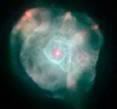|
|
Post by glactus on Feb 21, 2008 4:25:50 GMT
 In the image above we are looking at the Rho Ophiuchi dark cloud, captured by NASA's Spitzer Space Telescope. It's one of the closest star-forming regions to the Earth, located a mere 407 light-years away. The nebula is mostly a large cloud of molecular hydrogen. This is the main material that all stars form from. Some gravitational event caused a cloud of this hydrogen to collapse down, condensing into vast regions of star formation. The colours look nice, but that's not what you'd actually see if you could travel to "Rho Oph". Its colours were chosen by astronomers to clearly highlight the various temperatures and evolutionary stages of the various stars. The young stars are surrounded by disks of gas and dust, and show up as red in the image. The extended white nebula in the centre right of the image is glowing bright in infrared radiation because of the dust there has been heated by bright young stars. The rest of the stars forming are concentrated into the filament of cold, dense gas that shows up as a dark cloud in the lower centre and left side of the image.  IC 4593  credits This is part text only. See image, full text and all scientists involved at universetoday.com www.universetoday.com/2008/02/12/young-stars-in-a-blanket-of-gas-and-dust/#more-12790 Article credit: Fraser Cain |
|
|
|
Post by Andy Mac on Feb 21, 2008 5:29:38 GMT
Thanks for the post, Henry. This area of the sky as got to rank as one of the stronger contestants for being the most colourful regions in the sky.
|
|